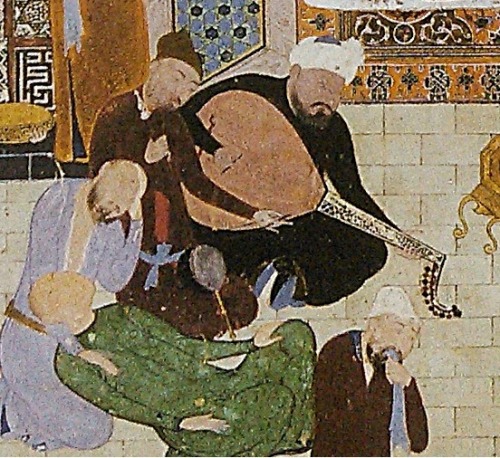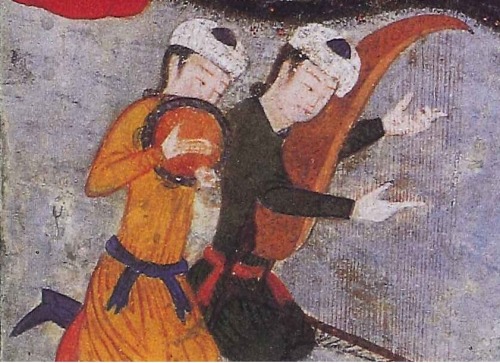
We often see art historians who work on the Middle East talking about the absence or irregularity of historical sources in the region and methodological problems resulting therefrom.
This issue is even more complicated when it comes to the music history of the Middle East and Central Asia. This is the history of “something” that does not have any concrete artwork, neither a recording nor a music script, unlike in other areas of art history such as literature or architecture that make possible detailed examinations. What could have survived of the music of a community that did not prefer to use musical notation as a means of transmission? There are historians who try to deduce as much as possible through some old rare scripts that contain musical notation, written after the seventeenth century in Ottoman Istanbul. However, if you are working on the music history of Central Asia before the 16th century—like me—then you have to swim in the ocean of the unknown. There is no music or musical notation from that period, except for some music theory books from which it is difficult to obtain accurate knowledge about the music itself, but definitely, there are many other sources that talk about music!
In my case, I had to utilize almost all of the written sources available, produced by a very wide intellectual circle, including historiographers, painters, and poets. Other than music treatises of the period, the forms of instruments drawn in miniatures and the musician biographies described in the historiographies also shed light on my studies. Among these helpful sources, I will talk about a didactic poem, which is very interesting, charming, and pleasant to read.
‘Telli Sazlar Münâzarası’ (The Debate of String Instruments) is a 15th century ‘Mesnevî’[1], written by Ahmedî in Herat. Gönül Alpay made a general translation of the text in 1972. Kemal Eraslan, published the work in 1986 and emphasized the language of the work. Then, in 1987, Bodrogligeti published an article which revealed the grammatical structure of the work.
In the work, eight stringed instruments that represent classes of people symbolically debate with each other, praising themselves, arguing for each other’s deficiencies, and thus giving advice to people in a didactic way. Even if the aim was to teach people to learn from these battles, the words of the instruments give many clues for a musicologist in need of a crumb of information.
The names of the debating instruments are all of the stringed instruments: ‘Tanbûre’, ‘Ud’, ‘Çeng’, ‘Kopuz’, ‘Yatuğan’, ‘Rebab’, ‘Gıcek’, and ‘Kingire’. After a short preface in prose, the first chapter of Mesnevî describes where the instruments are discussing and about what. Briefly, one night the poet hears noises from a ‘Meyhâne’ (’Harâbât’ – Tavern)[2] while he is wandering. When he goes to the ‘Meyhâne’, he sees the tavern keeper lying on the floor with a wine bottle in his hand and the instruments start to argue among themselves. The poet approaches the door curiously and listens to their speech. The second part of the ‘Mesnevî’ consists of the conversations of these instruments.
‘Tanbûre’ speaks of himself as having the cleanest harmony among all instruments, and such influential melodies that he can melt stone. For this reason, all instruments must be tuned in line with ‘Tanbûre’. In the rest of the ‘Mesnevî’, composed of the antithesis of these arrogant words of ‘Tanbûre’, the other instruments convey their characteristic features.
The leading role of ‘Tanbûre’ in ‘Mesnevî’ proves that it was widely used in Central Asia at the time. The ‘Ud’ follows ‘Tanbûre’ and states that he (Ud) knows all the meanings of life, his melodies are as burning as the aloes wood, no instrument can have a harmony like himself, and therefore he is played only in the ‘meclises’[3] of the kings. Ud claims himself as the genius of the instruments, because every ‘Makam’[4] can be played by him. It is a fact that the ‘Ud’ is the instrument used to describe some theoretical issues in the musical treatises of the period. In response to ‘Ud’, ‘Tanbûre’ likens ‘Ud’ to a potbellied teacher and a pregnant woman. This answer confirms that the shape of the ‘Ud’ at the period was similar to its present form. Here we see the main metaphor of the poet as a criticism of the scholars of the time, who only brag about their knowledge and usually gain weight because of the lack of movement.

Figure 1: ‘Ud’ and ‘Rebab’. A detail from a fifteenth century Timurid miniature.[5]
Another interesting dialogue is the debate of ‘Tanbûre’ with ‘Çeng’. ‘Çeng’ refers to herself as the essence of life and entertainment, always being on the shoulders of the people, chatting with the kings, and traveling with the epicures. In fact, these words emphasize that the ‘Çeng’ was widely used in the culture of court entertainment. Other literal sources reveal that the ‘Çeng’ represents a woman who often entertains the kings. According to ‘Çeng’, ‘Tanbûre’ is like a handkerchief in boys’ hands. Consequently, ‘Çeng’ points out that ‘Tanbûre’, which is used as much as a handkerchief, is played by the lower class. In response to ‘Çeng’, ‘Tanbûre’ says that ‘Çeng’ is curved and ugly shaped, and cannot be tuned properly. This information confirms that Çeng was a fretless instrument that made it difficult to play in Makam music tradition. ‘Tanbûre’ despises ‘Çeng’ by saying, “I can move you with my fingers,” but it also means that ‘Çeng’ was played with fingers.

Figure 2: ‘Çeng’ and ‘Def’. A detail from a fifteenth century Timurid miniature.[6]
After the other instruments debate with ‘Tanbûre’ in a similar way, at the end of the ‘Mesnevî’, the tavern keeper is disturbed by the noise, wakes up, and reprimands the instruments. They complain about ‘Tanbûre’, and ‘Tanbûre’ defends himself. The tavern keeper makes ‘Tanbûre’ apologize to other instruments to restore their friendship.
Of course, the main purpose of the ‘Mesnevî’ was not to show the musical knowledge of the poet, or to introduce the instruments of the period, but to criticize the human characters and classes of the period through the instruments. In this context, Gönül Alpay, in her article, shows that the poet refers to certain positions and characters through the features of the instruments. For example, while the Ud represents the scholarly class of society, ‘Çeng’ represents people who entertain the courtiers, and ‘Kopuz’ represents the nobleman-soldier class.
However, in addition to these socio-cultural metaphors, there is a lot of other information that a musicologist can infer from the ‘Mesnevî’. The work supports knowledge in the literature about the shapes of instruments used in fifteenth-century Central Asia and their places and prevalence in social life. In addition, there is also a question that may only occur to a musicologist’s mind: Why was there no wind or percussion instruments in the ‘Meyhâne’, and were all instruments stringed? This is a question that is yet to be answered.
Selected Bibliography
ALPAY, Gönül, 1972, “XV. Yüzyılın İlk Yarısında Yazılmış Bir Münazara: Sazlar Münâzarası”, Dil ve Tarih Coğrafya Fakültesi, Felsefe Araştırmaları Enstitüsü Dergisi, X, Ankara, s.99-132.
BODRODLİGETİ, Andras J.E., 1987, “A Masterpiece of Central Asian Turkish Satire: Ahmadi’s A Contest of String Instruments”, Ural-Altaic Yearbook, 59, s.55-58.
ERASLAN, Kemal, 1986, “Ahmedî Münazara (Telli Sazlar Atışması)”, Türk Dili ve Edebiyatı Dergisi, XXIV – XXV, İstanbul, s.129-204.
_______________________________________________________________________
[1] Mesnevî (Arabic: مثنوي mathnawī) or masnavi (Persian: مثنوی) is the name of a poem written in rhyming couplets, https://en.wiktionary.org/wiki/mesnevi
[2] “Meyhâne” means house of wine and is composed of two Persian words: mey (wine) and khāneh (house). “Harâbât” is the Arabic and more symbolic expression of this word. https://en.wiktionary.org/wiki/meyhane
[3] Meclis (or Mejlis; Arabic: مجلس) is an Arabic term meaning “a place of sitting”, used in the context of “council”, to describe various types of special gatherings among common interest. https://en.wiktionary.org/wiki/majlis
[4] A system of pitch organization in music for creating melodies and improvisation within a scale. https://en.wiktionary.org/wiki/maqam
[5] Herat, 1488-89. National Egyptian Library, Kahire. Adab Farsî, 908.6.
[6] Yezdī, Zafarnameh, Shiraz 839/1436. Cambridge, Harvard University Art Museum.

